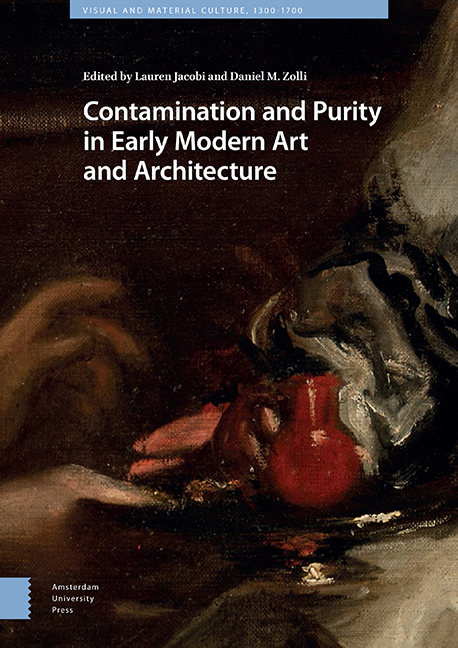Book contents
- Frontmatter
- Contents
- List of Illustrations
- Introduction: Contamination and Purity in Early Modern Art and Architecture
- 1 Generation and Ruination in the Display of Michelangelo’s Non-finito
- 2 The Sacrilege of Soot: Liturgical Decorum and the Black Madonna of Loreto
- 3 Sedimentary Aesthetics
- 4 ‘Adding to the Good Silver with Other Trickery’ : Purity and Contamination in Clement VII’s Emergency Currency
- 5 Tapestry as Tainted Medium: Charles V’s Conquest of Tunis
- 6 Bruegel’s Dirty Little Atoms
- 7 Leakage, Contagion, and Containment in Early Modern Venice
- 8 Contamination, Purification, Determinism: The Italian Pontine Marshes
- 9 Colonial Consecrations, Violent Reclamations, and Contested Spaces in the Spanish Americas
- 10 Contamination | Purification
- Index
1 - Generation and Ruination in the Display of Michelangelo’s Non-finito
Published online by Cambridge University Press: 27 May 2021
- Frontmatter
- Contents
- List of Illustrations
- Introduction: Contamination and Purity in Early Modern Art and Architecture
- 1 Generation and Ruination in the Display of Michelangelo’s Non-finito
- 2 The Sacrilege of Soot: Liturgical Decorum and the Black Madonna of Loreto
- 3 Sedimentary Aesthetics
- 4 ‘Adding to the Good Silver with Other Trickery’ : Purity and Contamination in Clement VII’s Emergency Currency
- 5 Tapestry as Tainted Medium: Charles V’s Conquest of Tunis
- 6 Bruegel’s Dirty Little Atoms
- 7 Leakage, Contagion, and Containment in Early Modern Venice
- 8 Contamination, Purification, Determinism: The Italian Pontine Marshes
- 9 Colonial Consecrations, Violent Reclamations, and Contested Spaces in the Spanish Americas
- 10 Contamination | Purification
- Index
Summary
Abstract
Michelangelo Buonarroti left nearly half of the many sculptures he carved in his lifetime unfinished, their rough surfaces transgressing early modern norms of finish and decorum. Nonetheless these objects (called non-finito/i) were preserved, collected, and displayed in their incomplete states. This paper examines the sites in which Florentine and Roman collectors exhibited Michelangelo's unfinished statues and demonstrates how the display strategies implemented within these sites sought to offset the expectation of finish that the non-finito failed to meet. By situating roughed sculptures within frameworks that evoked natural forces of accretion and generation or conjured archaeologies of ruination and restoration, collectors strategically blurred artistic, natural, and, temporal agency and fundamentally shaped how the viewer perceived and evaluated Michelangelo's most anomalous works.
Keywords: collecting, decorum, fragment, nature, non-finito, time
When Michelangelo Buonarroti relocated permanently from Florence to Rome in September 1534, he left the Medici Chapel (New Sacristy) in San Lorenzo as a work in progress: its architectural ornament was mostly in place and the two ducal portraits were complete and installed, but nearly all of the remaining statues were unfinished (Fig. 1.1). A few of these marble figures were in ‘the room where [Michelangelo] worked.’ Another four, all with different degrees of surface polish and corporeal finish, sat on wooden benches on the floor of the chapel itself alongside full-scale clay models of figures yet to be blocked in stone, giving the space the aspect of an artist's studio. Over the next thirteen years, as Michelangelo ignored requests that he complete his work, Cosimo I de’ Medici (1519–1574), the site's inherited patron, permitted foreign dignitaries, local patricians, intellectuals, and artists to visit the incomplete chapel and marvel at its informal array of sculpture. In 1546, despite Michelangelo's continued absence, the allegories of Night, Day, Dawn, and Dusk were mounted on their designated pedestals in their extant states. Sometime in the 1550s, Michelangelo's chisel-marked Madonna and Child was transferred to the chapel and installed along the unornamented back wall with the more polished St. Damian, St. Cosmas and trophies. When the chapel officially opened in 1561 it looked much as it does today. Yet modern eyes accustomed to unfinishedness in art too easily overlook the radicality of this display.
- Type
- Chapter
- Information
- Publisher: Amsterdam University PressPrint publication year: 2021
- 1
- Cited by

